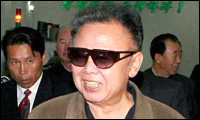Debunking late Kim Jong-il golf myth
That the late Kim Jong-il scored 11 holes-in-one in a round of golf has become the classic illustration of the lengths the North Korean regime will go to exalt its leaders. But outside media that have told the story may want to take a mulligan and try again.
From obituaries following Kim’s death last year to lists of the strangest “facts” about him, it is often reported that Pyongyang’s media has propagandized the dictator’s feats on the course.
But the tale appears to have been spread ― and exaggerated ― largely by outside media.
For answers, one need go no further than Eric Ellis, the Australian journalist who came upon the story while daringly reporting in the North in 1994 under the guise of a golf professional.
Ellis, then a correspondent for the Australian Financial Review (AFR), was interested in the country following the death of country founder Kim Il-sung just months prior. But he kept up his act as a golf course developer and his government-appointed minders took him to Pyongyang Golf Club, where he played nine holes.
He was met by the club’s “professional,” one of the few people at the facility. Ellis chatted with the man about a large image of country founder Kim Il-sung he had noticed at the entrance of the course.
The senior Kim never teed off there, the pro said but his son, Kim Jong-il, had.
Turns out, it was five holes-in-one, not 11.
“I said: ‘Was he a good golfer?’ He said: ‘He’s amazing,’” said Ellis, now Europe correspondent for The Global Mail and based in Amsterdam, over the phone. The pro, who was being carefully monitored, said the five aces led to a record-shattering round of 34.
“It was an example of how scared people are and twisted their minds are that they feel they have to go to such lengths to tell such a ludicrous story. I felt sorry for him,” Ellis said.
The reporter recounted the story in the AFR and later for the International Herald Tribune.
He is not sure how the five holes-in-one became eleven but likened it to a game where children whisper a phrase to each other in a circle “and suddenly the story at the end of the line is totally different than what happened.” Other details such as the number of bodyguards surrounding Kim and that it was his first and only round were added later.
Brian Myers, a North Korean propaganda expert at Dongseo University, said the regime was unlikely to promulgate the story because “golf is a seen as an upper-class sport” and that he had never seen it in propaganda material.
He said tour guides at sites where leaders visit are armed with legends to tell visitors but they are not a part of national propaganda.
North Korea’s propaganda — which is often extravagant, belligerent or strange to outsiders — aims to build a personality cult around the ruling Kims, including current leader Kim Jong-un. It is a country where verb tenses are explained with different versions of the phrase, “We fight against the Yankees.”
But Myers said the fixation on the strange can distort the regime’s messages.
“The daily reality of North Korean propaganda is that it is heavily focused on the military. The last thing the propaganda apparatus would have wanted to emphasize (about Kim) was his skill at playing a game,” he said.
The propaganda is often taken out of context, he argued, citing the reaction to North Korean media reports that in the wake of Kim Jong-il’s death, the “sky seemed to grieve” and that nature was “heartbroken.”
An outside “journalist might say the same thing if at the funeral of a beloved leader it began to rain, and it was as if the sky was crying. Yet when North Korea engages in this, we take it very literally. That really distorts the reality of that country, which has no time at all for anything that smacks of the supernatural.”
For Ellis, the original story may be interesting enough on its own.
“North Korean propaganda is really bizarre even without anyone trying to embroider it,” he said. <The Korea Times/Kim Young-jin>

























































